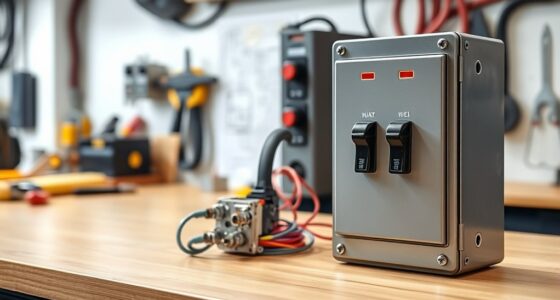NEC highlights for standby systems emphasize that you must install automatic generators and transfer switches to guarantee critical loads like hospitals or fire safety systems stay powered during outages. These systems need to switch on within 60 seconds, with proper load management and safety features. Regular testing and maintenance are essential to keep everything running smoothly. If you want to understand how to balance safety, compliance, and performance, keep exploring these key points further.
Key Takeaways
- NEC requires standby generators to automatically transfer power within 60 seconds during outages.
- Proper sizing and load management are essential to ensure all critical loads are powered safely.
- Listed transfer switches must prevent back-feeding and ensure reliable, code-compliant operation.
- Grounding, bonding, and wiring must meet NEC standards for safety and fault current capacity.
- Regular testing, maintenance, and documentation are mandatory to ensure system reliability and code compliance.
Understanding Legally Required Standby Systems

Legally required standby systems are essential backup power sources mandated by authorities having jurisdiction (AHJ) to guarantee critical loads stay operational during utility power failures. These systems automatically supply power to specific non-emergency loads, such as safety systems or manufacturing processes, when the utility grid fails. Their purpose is to prevent safety hazards, financial losses, or regulatory violations, especially in critical facilities like vaccine manufacturing plants or smoke control systems. The AHJ determines which loads are covered and sets system requirements based on local codes. These systems must start and provide power within 60 seconds of a power outage, differing from emergency or optional standby systems. Their design and operation are strictly regulated to ensure reliability and compliance during critical moments.
Key Performance and Operation Standards

Ensuring standby systems perform reliably requires adherence to strict standards for testing, maintenance, and capacity. You must conduct operational testing to confirm power transfers within 60 seconds of utility failure, and follow manufacturer instructions and recognized industry standards for maintenance. Document all tests and ongoing battery checks for compliance and future reference. Qualified personnel or accredited firms should handle maintenance tasks, especially on overcurrent protective devices, to prevent malfunctions. Equipment must withstand fault currents safely, and the power source should have enough capacity to handle all expected loads, including transient changes. Load management systems must prioritize critical loads and be capable of shedding non-essential ones if capacity is limited. Following NFPA 110 standards ensures your system’s performance aligns with defined classes, types, and levels for reliable operation. Proper testing and maintenance procedures are essential for early fault detection help identify potential issues before they cause system failure.
Critical Loads and Application Areas

Understanding how standby systems prioritize different loads is key to maintaining reliable operation during power outages. Critical loads are the essential circuits or equipment that must stay powered, like life safety systems, fire alarms, ventilation, and essential building controls. They’re chosen based on risk assessments and building codes, with the NEC specifying response times—legally required systems must activate within 60 seconds. These loads apply across sectors such as healthcare, public safety, water systems, and transportation. To manage capacity, standby systems may shed non-critical loads automatically or manually. Proper load prioritization ensures system reliability and safety. It is also important for users to understand the Affiliate Disclosure and privacy policies related to the systems’ monitoring and reporting tools. Use this table to see where critical loads are typically applied:
| Application Area | Critical Loads |
|---|---|
| Healthcare | Life-support, ventilation, communication |
| Fire & Safety | Fire alarms, smoke control, emergency communications |
| Water & Sewage | Pumps, controls for environmental safety |
| Transportation | Tunnel, airport, transit communication, and control systems |
Ensuring Proper Testing and Maintenance

Regular testing and maintenance are essential to keep standby systems reliable when you need them most. After installation, the Authority Having Jurisdiction (AHJ) must witness or conduct acceptance testing to guarantee the system meets specifications. The system should start within 60 seconds of a utility outage, and load testing verifies performance under expected conditions. Audible and visual alarms help detect malfunctions during testing and operation. Automatic transfer switches must be checked to ensure seamless power transfer without connection issues. Periodic testing is mandatory, often guided by manufacturer recommendations or AHJ rules, including running the generator under load. Maintenance involves inspecting fuel, batteries, electrical connections, and transfer switches, with detailed records kept for proof of ongoing compliance. Only qualified personnel should perform testing and maintenance, following safety protocols. Incorporating proper testing procedures ensures consistent system performance and safety compliance.
Compliance With Codes and Installation Tips

Proper compliance with electrical codes and installation standards is essential for the safety and reliability of standby systems. You must size your generator to handle all expected loads simultaneously, or implement load shedding to prioritize critical circuits if capacity is limited. Use automatic transfer switches listed for emergency use to prevent dangerous back-feeding and ensure proper connection methods, like installing ahead of the main disconnect if approved. Equipment must be suitable for available fault currents and located to minimize hazards from floods, fires, or vandalism. Testing by the AHJ is mandatory after installation, with regular maintenance logs kept. Grounding, bonding, and wiring must meet NEC standards, and signage should clearly identify the power source to protect responders. Generator capacity should be verified with load calculations or approved methods to ensure it can meet all operational demands. Proper installation and adherence to wiring basics help prevent electrical failures and hazards. Following these rules guarantees your system’s safety and compliance.
Frequently Asked Questions
How Do I Determine if My System Qualifies as a Legally Required Standby?
To determine if your system qualifies as a legally required standby, you need to check with your local AHJ’s regulations and building codes. They’ll evaluate your facility’s type, occupancy, and hazard potential. If your system supports critical operations like firefighting, rescue, or safety-related functions, it likely qualifies. Consult with the AHJ or a qualified engineer to confirm whether your system meets the specific criteria for a legally required standby system.
What Are the Specific Documentation Requirements for System Testing Records?
Think of your testing records like a detailed map guiding you through your system’s health. You must document acceptance tests, periodic operational tests, maintenance actions, and any corrective steps. Include test dates, who performed them, equipment tested, and results. Keep records clear, legible, and thorough. These logs serve as proof for authorities, help prevent liability issues, and assure everyone understands your system’s status at a glance.
Can Legally Required Standby Systems Be Installed Outdoors?
Yes, you can install legally required standby systems outdoors if you follow NEC requirements. You must guarantee the outdoor disconnecting means is accessible, within sight, and properly labeled. Wiring must meet Chapter 3 standards, and transfer switches should be listed for emergency use. Also, signage, alarms, and secure access are essential for safety and compliance. Proper installation and maintenance by qualified personnel are critical for outdoor standby system safety.
How Often Should Battery Maintenance Be Performed for These Systems?
You should perform battery maintenance weekly, monthly, and periodically to guarantee optimal performance. Weekly, check electrolyte levels and voltages; monthly, conduct load testing to verify functionality; and periodically, inspect, clean terminals, and replace batteries as needed. Keeping accurate records of all tests and maintenance activities is essential for compliance. Regular upkeep prevents early degradation, ensures reliable power within the NEC’s 60-second requirement, and maintains system readiness for emergencies.
What Are the Penalties for Non-Compliance With NEC Standby System Requirements?
If you don’t comply with NEC standby system requirements, you risk facing fines, code violations, and possible suspension of occupancy or operating permits. You could also encounter legal liabilities for damages caused by power failures, increased insurance premiums, and denial of claims. Non-compliance endangers safety, disrupts critical operations, and may result in costly shutdowns or legal actions, emphasizing the importance of adhering to all NEC regulations for your standby systems.
Conclusion
Ensuring your standby systems meet NEC standards isn’t just about compliance—it’s about safety. Did you know that proper testing and maintenance can reduce system failures by up to 90%? By understanding key performance standards, critical load requirements, and following installation tips, you can keep your system ready when you need it most. Stay proactive, stay compliant, and protect your property and loved ones with reliable standby power you can trust.










